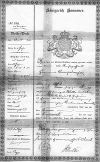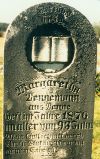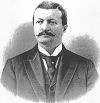|
Venne - emigration
history Between 1832 and 1900 about 2.000 people from Venne emigrated to the USA. What made them go? Most of them had economical reasons. Farming was the main source of income, but the land could not feed all its people anymore. From the times of the 30-Years-War (1618 to 1648), when Venne had 650 inhabitants, the population had grown to 2.000 in the year 1848. Only one child could inherit the farm. The sisters and brothers had to marry on other farms or stay unmarried at home unless they wanted to descend to the lowest class of the rural society of the 19th century: to become a cottager, the so called "Heuermann (hireman)". Hiremen rented little farmhouses, cottages, from the biggers farms. The rent had to be payed in money and, even more important, by working for the farmowner in his farming business. Children of these hiremen only had one single fate: to become hiremen like their parents. If they did not find a house and land to rent, they were not allowed to marry. Living standard of the rural society of Venne was extremely low. From an average family with 6 children only 4 reached maturity. A poor harvest in 1846 even caused a famine the next year. Everyone tried to make some additional money: the hiremen jobbed as taylors, wooden shoe makers, carpenters, wagonmakers, smiths or joiners. Venne belonged to the principality of Osnabrueck, one of for a time more than 300 small states in Germany. In 1815 Osnabrueck was incorporated into the kingdom of Hanover which in 1866 itself was incorporated into Prussia. Many young men tried to avoid beeing drafted to military service. We don´t know who the very first Venne emigrant to the USA was, but once emigration had started it soon became a mass movement. Good news from the new land caused a chain reaction; more and more came: sisters and brothers, other family members, relatives, friends and neighbours were given the letters written by their predecessors telling about ten times higher income and cheap land to purchase. A dream, never really dared to be dreamed in Germany, looked to be realizable: to become a selfstending farmer on your own property. The class of the hiremen and their children saw a big chance for their lives. Consequently they produced 80 % of the emigrants. The others were farmers or their children. In nowaday terms in Germany we call these kind of people economical refugees. From the former principality of Osnabrueck it were 90,000; from Venne itself about 2,000 within a period of 70 years (1830 - 1900). About 50% of the Venne emigrants went to the big cities like Pittsburgh PA, Buffalo NY, Cincinnati OH, St. Louis MO, Louisville KY, Kansas City KS, Terre Haute IN and Jersey City NJ. The second half of the emigrants homesteaded in rural areas of the states of Ohio, Indiana, Illinois, Iowa, Missouri and Kansas. You can learn more about the Venne emigration history in this book:  You can order the English editon of Venne in America($ 28,-- plus shipping) from the author Udo Thoerner: Udo.Thoerner@Campemoor.de. |
Members of these Venne families who emigrated to the United States of Amerika can be found in the book:
|
Abke Ahlbrand Andrees Beckmann Bergmann Bettenbrock Bonenkamp Borrenpohl Böschemeyer Bosse Brinkmann Brockschmidt Bruning Bücker Buhr / Buer Büning Bünte Burlage Castrup Dierker Dinkelmann Donnerschlag Dunker Düsterberg Ebke Eggemann Ellermann Evers Fangmeier Fissbecke Frische Gering Grautmann Grave Hachmann Hackmann Hagemann Harmeyer |
Havekotte Hehemann Hinnenkamp Hockmann Holland Hollenbecke Hollewedde Holtkamp Hurrelbrink Imbusch Imsieke Jakob im Busch Jösting Kalmey Kettler Klausing Kleekamp Knollhoff Knostmann Koch Köster Krone Laumerich Linnenschmidt Meyer zu Broxten Meyer zu Darpvenne Meyer zu Venne Meyer zum Vorwalde Meyerholz Miefert Minning Möhlenkamp Möhlmeyer Mönk, Mönnich Niederschmidt Niehaus Niemann Nölker |
Nordmann Ostendorf Otte Peter Peterschlingmann Pleggenkuhle Probst Pruss Rasche Riesmeyer Rittmann Rölker Rotert Rottmann Rückin Sander Schepmann Schevemann Schlarmeyer Schleibaum Schlingmann Schmalge Schmalgengerd Schmersal Schnieder Schomaker Schröder Schütte Schwarze Schwegmann Siebert Siegmann Sieksmeier Sielschott Siepmann Sievering Sollmann Spielmeyer |
Stagge Steinkamp Stockhowe Strobecke Strunk Stuckwisch Stüve Surenkamp Tepe Terkhorn Thelmann Thörner Tiemann Tiemeyer Topie Tormöhlen Trentmann Uhlenborg Ulland Vallowe Vennemann Vette Vinke von der Becke Vornholt Wahlbecke Waldkötter Waldmann Wamhof Wessel Wiedöwer Wilke Winter Wissmann Wortmann Wrampelmeier zu Broxten |












